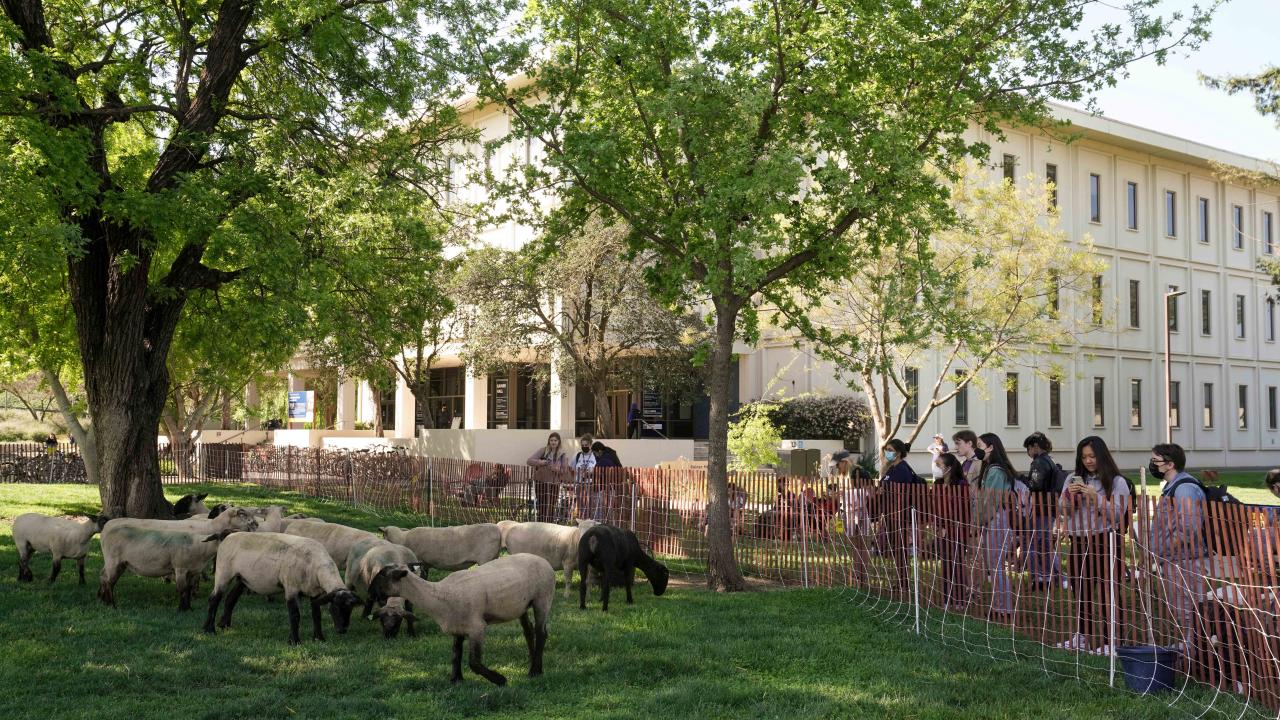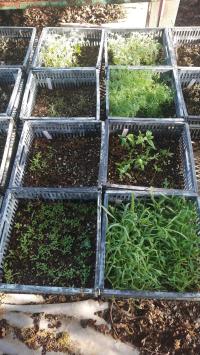
Sheep Mowers Return to UC Davis
Researchers exploring ecological and cultural benefits of integrating sheep on campus
Sheep Mower's Spring Quarter Schedule
Grazing hours: 9:30 a.m. to 3 p.m.
- Monday-Wednesday, April 25-27
- Wednesday-Friday, May 18-20
- Wednesday-Friday, June 8-10
People are flocking to campus once again to watch the UC Davis Sheepmowers in action. A flock of 25 sheep will be grazing on the chemistry mounds off Hutchison Drive next week as part of a continued experiment to discover the ecological and cultural benefits of integrating sheep into the university’s landscape maintenance routine.
Landscape Architecture Professor Haven Kiers launched the project last May to find out if sheep can eat grass and weeds, fertilize the grass and control pests better than conventional methods. The next grazing event is scheduled for April 25-27 outside Bainer Hall, not far from the Silo and Bike Barn. The highly visible site has more trees providing greater shade than last year’s grazing spot at Solano Field.
“I can’t speak with any scientific knowledge about how happy the sheep are, but I am convinced that they are living the good life,” Kiers said.
Researchers are analyzing environmental factors like grass length and soil fertility, as well as economic factors like fuel and labor costs. Kiers says according to initial findings, the sheep cut the grass just as short as the lawnmowers. And soil analysis from data collected last year shows that the soil was more fertile after the sheep grazed, compared to an adjacent traditionally landscaped lawn.
The benefits of sheep on campus

Kiers and her team have added more elements to their research this year, including visitor surveys to determine if sheep can help reduce stress and improve mental health. She says they’ve also partnered with local nonprofit organization Miridae Living Labs to analyze the types of insects that are found at the site.
“We’re hoping that the sheep will bring all sorts of beneficial insects in with them as they fertilize the land,” Kiers said.
Waste wool, or the short strands of wool from the animal’s belly and underside, is also being studied to see if it can be valuable in the garden. Kiers said Miridae tried a non-scientific experiment of using the waste wool as a binder to help with the root growth of native plants.
“When comparing the plants in the wool treatment to the plants in regular mulch, the plants in the wool were bigger and greener and more vibrant,” Kiers said.
During Crowdfund UC Davis in February, the sheepmower project raised more than $8,300. Kiers said the money is being used to buy equipment, fund community events and support a new internship program. Kiers said there are 10 student shepherds who are responsible for herding the sheep, monitoring the grazing and working on social media and marketing strategies.
Lucy Yuan, a landscape architecture major, is working to complete a “Sheepscapes Catalogue” as her senior thesis by the end of spring. Kiers said the finished product will graphically illustrate all the ways sheep can be integrated into college campuses and include a step-by-step grazing implementation plan with the hope that other institutions adopt a similar program.
“It’s going to highlight all the benefits of using sheep on campus,” Kiers said. “It will include best practices and the pitfalls, so that this could be a booklet with practical steps to convince other campuses to do this.”
Special grazing event
Next week’s grazing event is designed to coincide with what would have been the 200th birthday of Frederick Law Olmsted, who is known as the “father of landscape architecture.” Olmsted is credited with being a co-designer of Central Park in New York City, which in the late 1800s until early 1900s featured sheep grazing on a meadow to provide maintenance and serve as a refuge from the stresses of urban living. To honor his work, Kiers said her team will be handing out free stickers and will host “Olmsted en Plein Air,” a watercolor painting event, during the sheep mowing. The team will also launch its new “Just Add Sheep” campaign that urges people to snap a photo of a “sheepworthy” outdoor space on social media (@UCDavis_sheepmowers) with the hashtag, #JustAddSheep.
“I still can’t believe this is research; it’s too much fun,” Kiers said. “I get to run around with sheep and talk about the benefits of mowing the lawn with sheep. It doesn’t get any better than that.”

Media Resources
A. Haven Kiers, Department of Human Ecology, ahkiers@ucdavis.edu
Tiffany Dobbyn, College of Agricultural and Environmental Sciences, tadobbyn@ucdavis.edu